Post WWII Publications on the
Wilhelm Gustloff
Wilhelm Gustloff



end of the war, she was still the seat of the last Reich President in Donensitz in Flensburg. On the "Milwaukee", the once-snowy, floating palace of the Mediterranean travelers, the capitulation talks between the German government and the Allies took place in May 1945. In 1946, it was awarded to the United States, but it burnt so thoroughly during the crossing in Liverpool that it had to be sold for scrapping. From the shipping ships of the shipping company the miseries fell into enemy hands. With the "Vorwärts" (800 BRT) bought by an English shipping company, HAPAG now operates a sea bathing service.

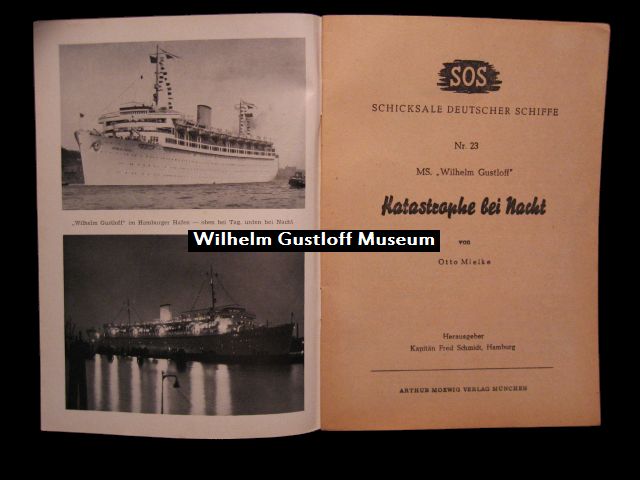
Schicksale Deutscher Schiffe - Nr. 23
Katastrophe bei Nacht - 1953
Passagier-Motorschiff "Wilhelm Gustloff"
Von Otto Mielke, Herausgeber, Captain Fred Schmidt, Hamburg.
Katastrophe bei Nacht - 1953
Passagier-Motorschiff "Wilhelm Gustloff"
Von Otto Mielke, Herausgeber, Captain Fred Schmidt, Hamburg.
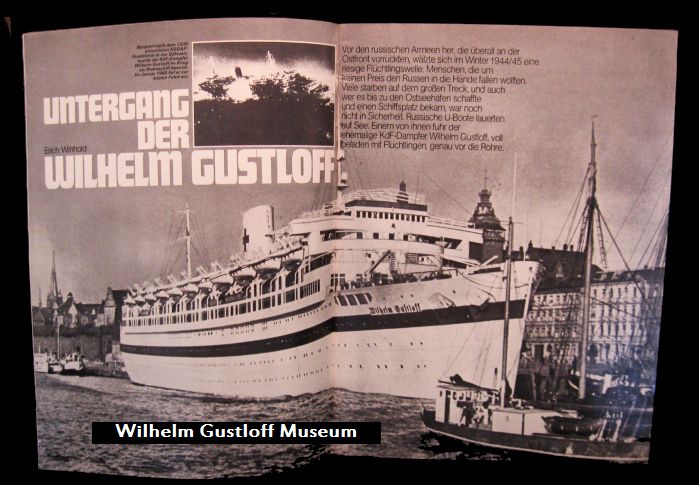
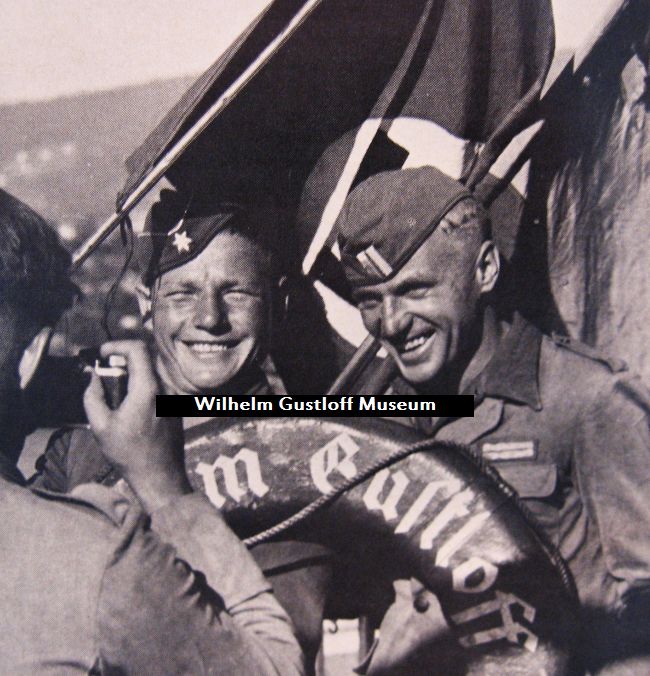
Das III Reich Nachkrieg - Nr. 53
Article: Untergang der Wilhelm Gustloff. 1977
Article: Untergang der Wilhelm Gustloff. 1977
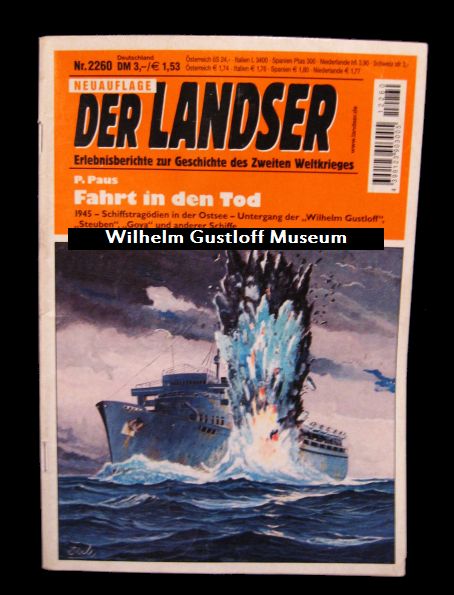
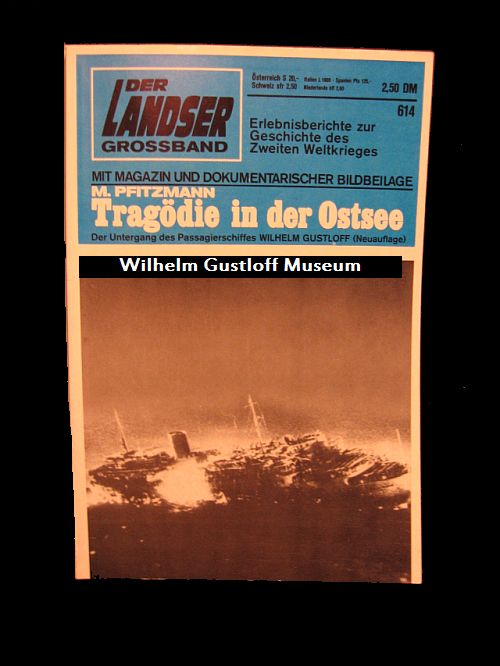
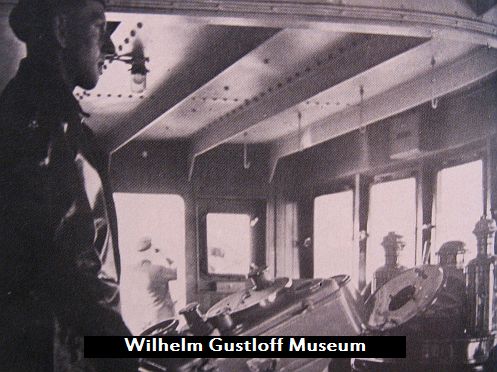
Der Landser - No Date or Number (left)
1945 - Schiffstragodien in der Ostsee - Untergang der 'Wilhelm Gustloff', 'Steuben', 'Goya', und anderer Schiffe.
Der Landser Sammelband Nr. 11 (right)
Der Untergang des Passagierschiffes Wilhelm Gustloff. Also features several photos of the ship including the hospital ship photo shown under Lazaratteschiff D and a photo of the Gustloff's bridge. (far right)
Both are believed to be early 2000 prints.
1945 - Schiffstragodien in der Ostsee - Untergang der 'Wilhelm Gustloff', 'Steuben', 'Goya', und anderer Schiffe.
Der Landser Sammelband Nr. 11 (right)
Der Untergang des Passagierschiffes Wilhelm Gustloff. Also features several photos of the ship including the hospital ship photo shown under Lazaratteschiff D and a photo of the Gustloff's bridge. (far right)
Both are believed to be early 2000 prints.
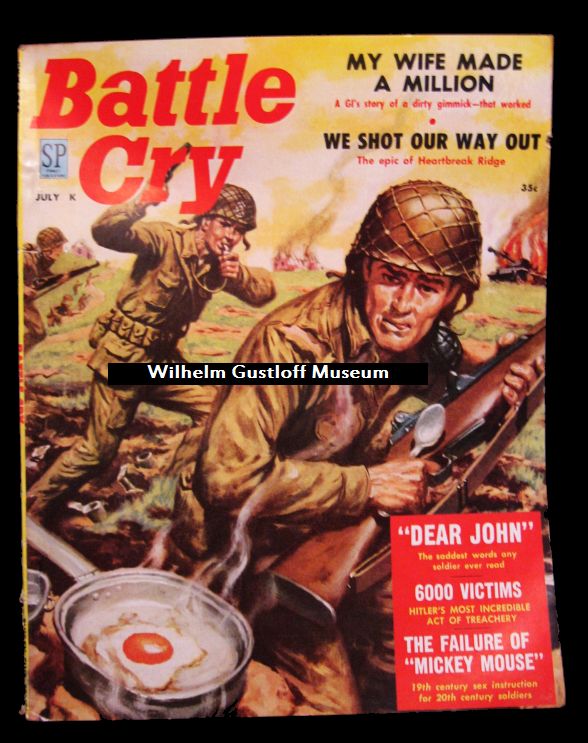
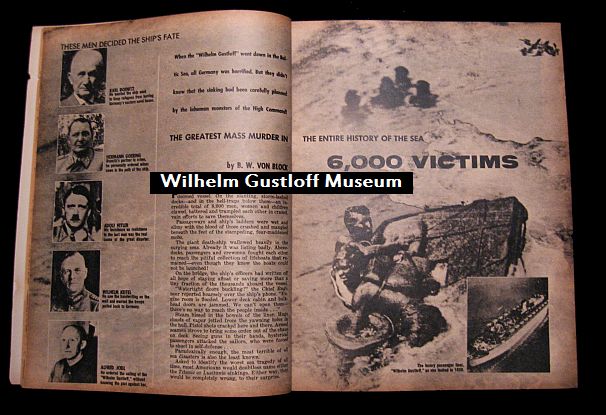
Battle Cry - July 1958, 6,000 Victims
- What makes the above article "6,000 Victims, Hitler's Most Incredible Act of Treachery" interesting is that it claims the Wilhelm Gustloff was intentionally sunk to avoid mass evacuations and show the sea evacuation route was too dangerous. By keeping people in Gotenhafen, the Nazi's could use them to fight the advancing Russians. It is a wild story that is more fiction than fact, but interesting regardless.
"These Men Decided The Ship's Fate"
Karl Doenitz: He wanted the ship sunk to keep refugees from leaving Germany's eastern naval bases.
Hermann Goering: Doenitz's partner in crime. He personally ordered (the Luftwaffe to lay) mines sown in the path of the ship. (Also states in the article that the original lifeboats were ordered taken off, the running lights of the ship were ordered on, she should sail in a direct path, and all area ships were ordered to avoid any SOS signals to have maximum death on board.)
Adolf Hitler: His insistence on resistance to the last man was the real cause of the great disaster.
Wilhelm Keitel: He saw the handwriting on the wall and wanted the troops pulled back to Germany.
Alfred Jodl: He ordered the sailing of the "Wilhelm Gustloff", without knowing the plot against her.
- What makes the above article "6,000 Victims, Hitler's Most Incredible Act of Treachery" interesting is that it claims the Wilhelm Gustloff was intentionally sunk to avoid mass evacuations and show the sea evacuation route was too dangerous. By keeping people in Gotenhafen, the Nazi's could use them to fight the advancing Russians. It is a wild story that is more fiction than fact, but interesting regardless.
"These Men Decided The Ship's Fate"
Karl Doenitz: He wanted the ship sunk to keep refugees from leaving Germany's eastern naval bases.
Hermann Goering: Doenitz's partner in crime. He personally ordered (the Luftwaffe to lay) mines sown in the path of the ship. (Also states in the article that the original lifeboats were ordered taken off, the running lights of the ship were ordered on, she should sail in a direct path, and all area ships were ordered to avoid any SOS signals to have maximum death on board.)
Adolf Hitler: His insistence on resistance to the last man was the real cause of the great disaster.
Wilhelm Keitel: He saw the handwriting on the wall and wanted the troops pulled back to Germany.
Alfred Jodl: He ordered the sailing of the "Wilhelm Gustloff", without knowing the plot against her.

SMS (Schiffe Menschen Schicksale) - January 1995
"Wilhelm Gustloff"
A great modern publication in German that features several photos of the Gustloff and a lot of information on her. 46 pages.
"Wilhelm Gustloff"
A great modern publication in German that features several photos of the Gustloff and a lot of information on her. 46 pages.
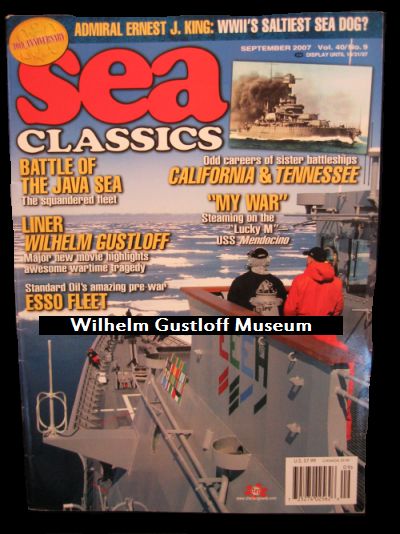
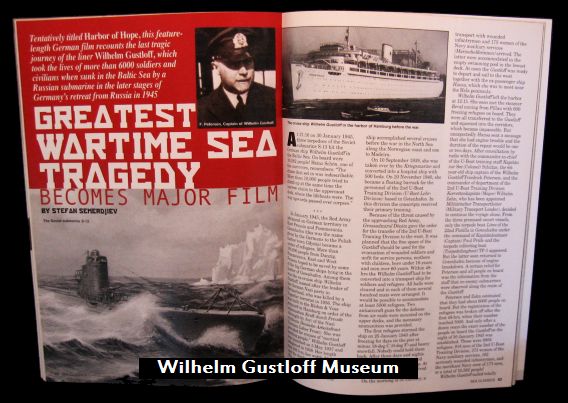
Sea Classics - September 2007
"Liner Wilhelm Gustloff, Major new movie highlights awesome wartime tragedy."
- Tentatively titled "Harbor of Hope", this feature length German film recounts the last tragic journey of the liner Wilhelm Gustloff, which took the lives of more than 6000 (we now know 9,500) soldiers and civilians when sunk in the Baltic Sea by a Russian submarine in the later stages of Germany's retreat from Russia in 1945.
"Liner Wilhelm Gustloff, Major new movie highlights awesome wartime tragedy."
- Tentatively titled "Harbor of Hope", this feature length German film recounts the last tragic journey of the liner Wilhelm Gustloff, which took the lives of more than 6000 (we now know 9,500) soldiers and civilians when sunk in the Baltic Sea by a Russian submarine in the later stages of Germany's retreat from Russia in 1945.
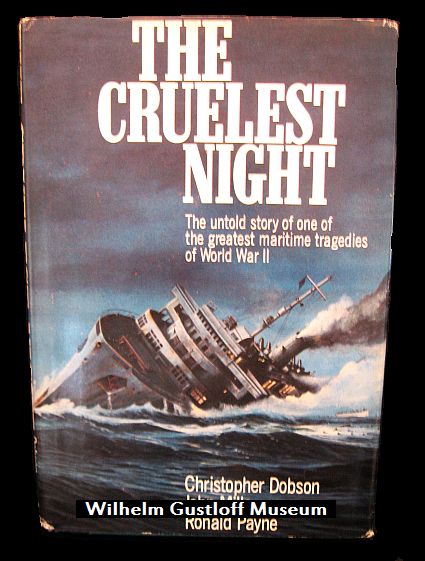
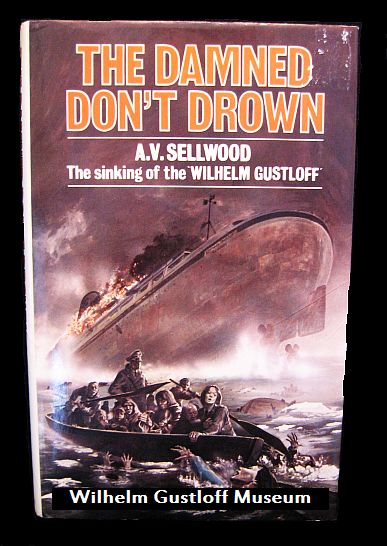
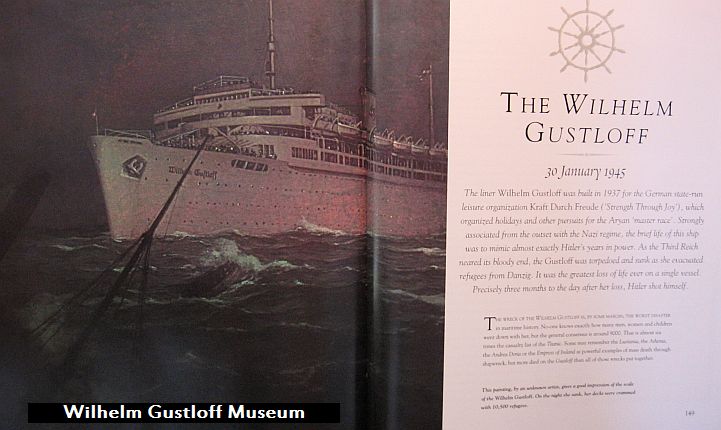
Shipwreck: A History of Disasters at Sea. By: Sam Willis 2008
- 6 pages of this book are dedicated to the Wilhelm Gustloff.
The Pegaway Rescue painting is on the front of the article.
- 6 pages of this book are dedicated to the Wilhelm Gustloff.
The Pegaway Rescue painting is on the front of the article.
The Cruelest Night (1977) & The Damned Don't Drown (1973)
- The two best books on the Wilhelm Gustloff that are published in English. Both are out of print.
- The two best books on the Wilhelm Gustloff that are published in English. Both are out of print.
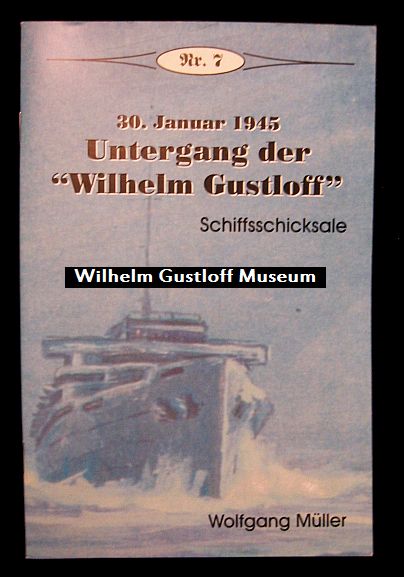
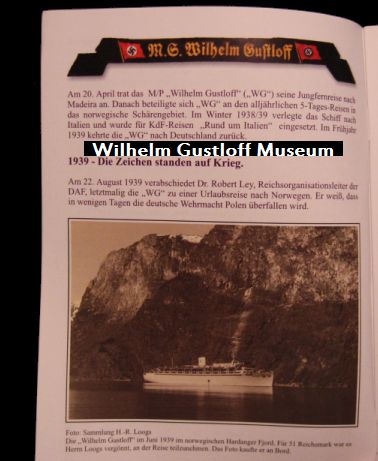
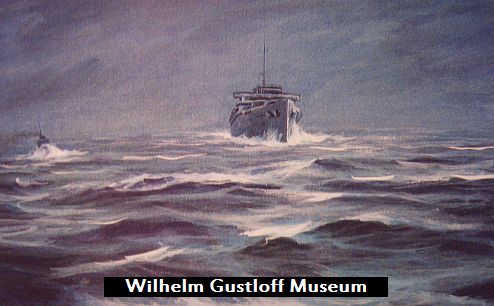
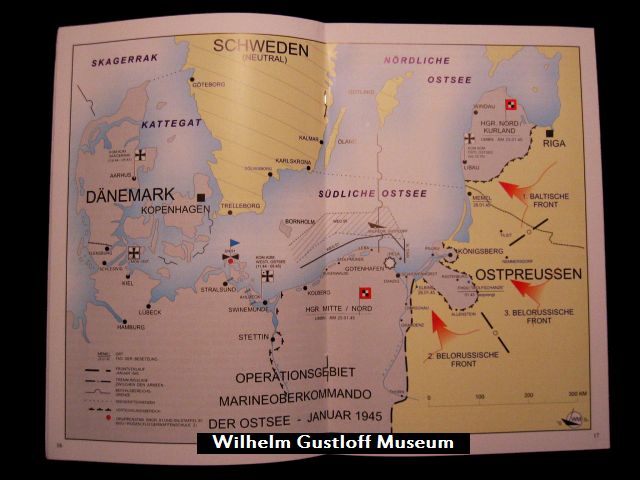
30. Januar 1945, Untergang der Wilhelm Gustloff - Nr. 7 - 2005
- A great mini book part of a larger series featuring the ship and including several photos including some shown.
- A great mini book part of a larger series featuring the ship and including several photos including some shown.

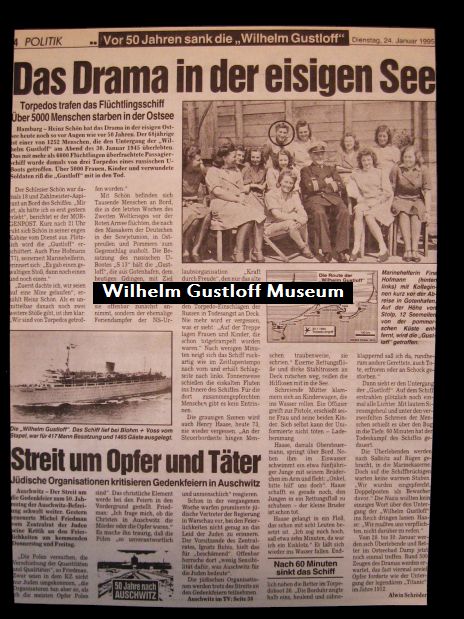
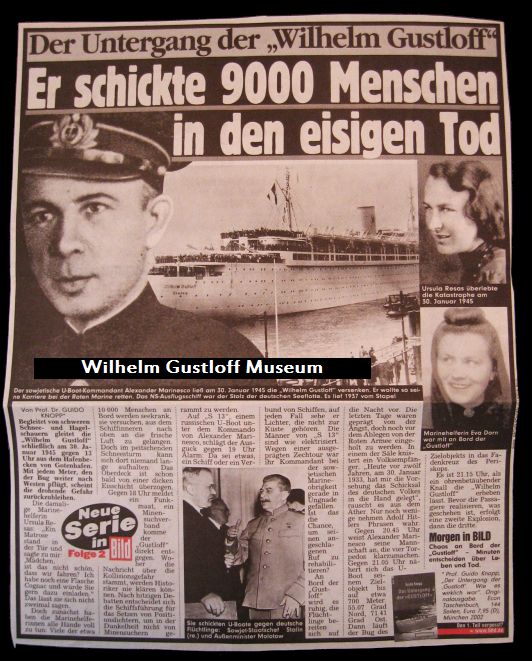
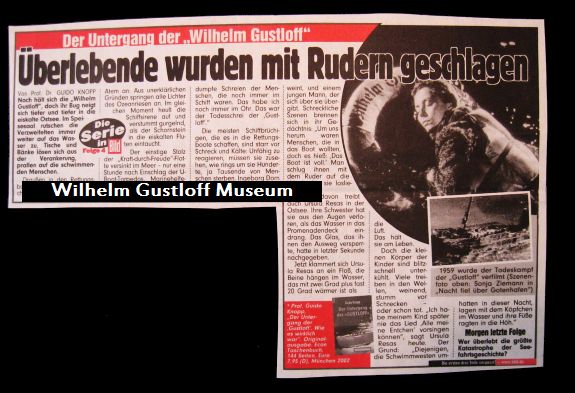
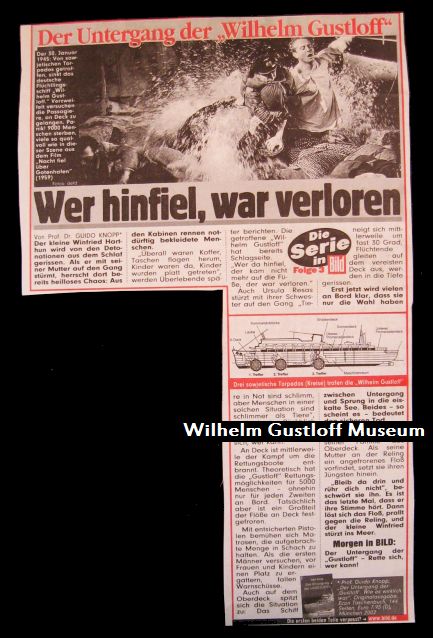
Der Untergang der 'Wilhelm Gustloff'
A collection of newspaper articles, 5 of 5 in a series discussing the Wilhelm Gustloff.
January, 1995.
A collection of newspaper articles, 5 of 5 in a series discussing the Wilhelm Gustloff.
January, 1995.



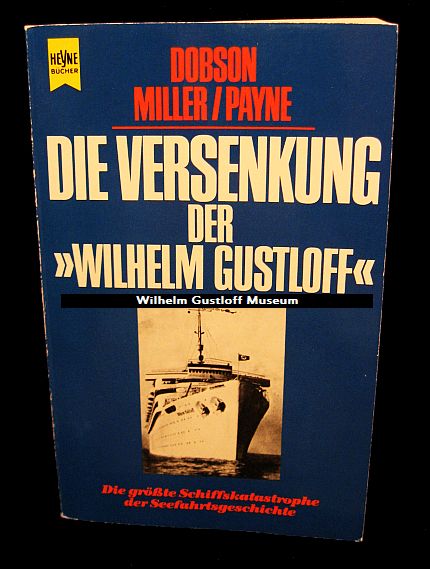
Die Versenkung Der Wilhelm Gustloff - Dobson, Miller/Payne - 1979
English: "The Sinking of the Wilhelm Gustloff"
English: "The Sinking of the Wilhelm Gustloff"

Der Stern Magazine
"Sinking of the Wilhelm Gustloff" article in two issues:
- March 14th, 1959
- March 21st, 1959
Interesting photos of the liner as Lazarettschiff 'D'.
"Sinking of the Wilhelm Gustloff" article in two issues:
- March 14th, 1959
- March 21st, 1959
Interesting photos of the liner as Lazarettschiff 'D'.

Der Spiegel: The German Titanic
February 4th, 2002
February 4th, 2002
The Titanic was a testimony of the hubris of a civilization that worshipped technology and thought it could conquer nature. The Gustloff, on the other hand, was the symbol of the German hubris, the dream of a greater German empire that ended in a nightmare. It was Adolf Hitler's Titanic.
Der Spiegel February 4, 2002
Der Spiegel February 4, 2002
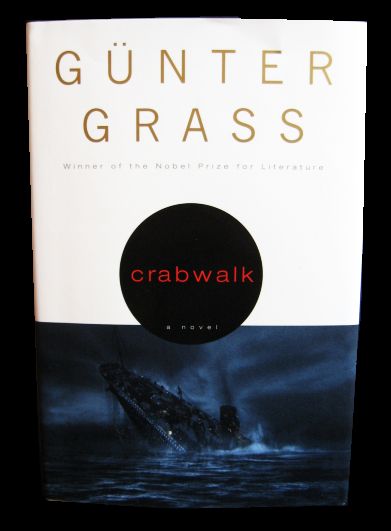
Gunter Grass - Crabwalk: 2002
Inside Cover: "Born to an unwed mother on a lifeboat the night of the attack, Paul Pokriefke is a middle-ages journalist trying to piece together the tragic events. While his mother sees her whole existence in terms of that calamitous moment, Paul wishes their life could have been less touched by the past. For his teenage son, who dabbles in the dark, far-right corners of the internet, the Gustloff embodies the denial of Germany's wartime suffering.
Below: A lanyard given to the employees who worked on the movie "Die Gustloff" in 2008.
Inside Cover: "Born to an unwed mother on a lifeboat the night of the attack, Paul Pokriefke is a middle-ages journalist trying to piece together the tragic events. While his mother sees her whole existence in terms of that calamitous moment, Paul wishes their life could have been less touched by the past. For his teenage son, who dabbles in the dark, far-right corners of the internet, the Gustloff embodies the denial of Germany's wartime suffering.
Below: A lanyard given to the employees who worked on the movie "Die Gustloff" in 2008.
Playbill:Nacht fiel uber Gotenhafen. 1960.
Official studio photos from the movie.
Official studio photos from the movie.
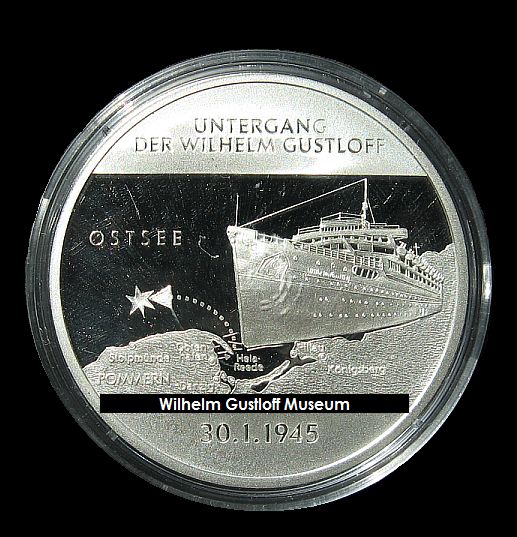
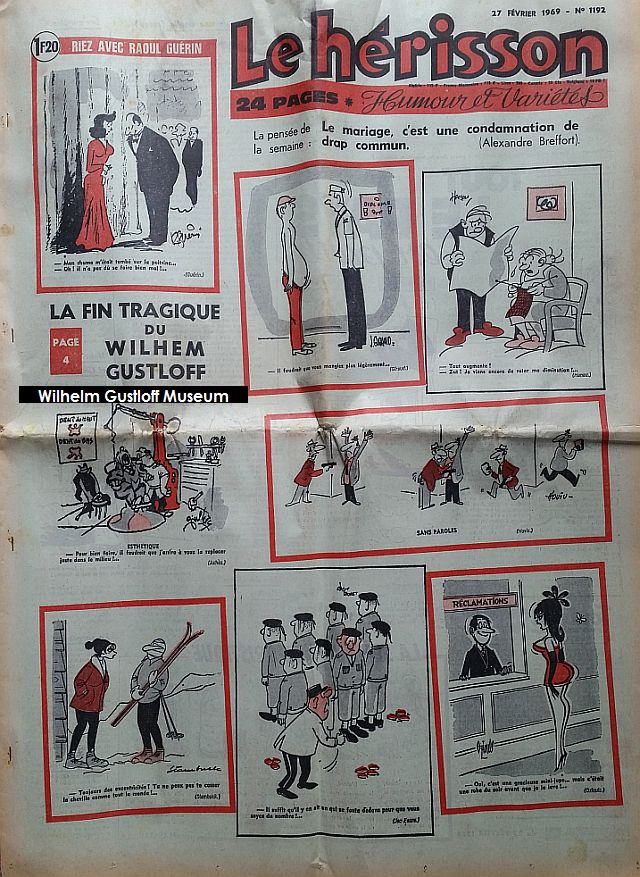
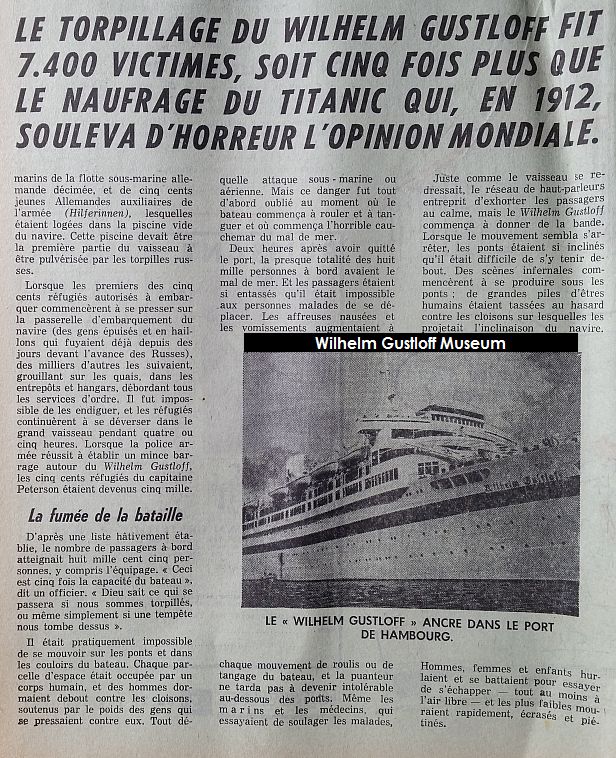
Le herisson - February 27th, 1969
The End of the Wilhelm Gustloff
French Newspaper
The End of the Wilhelm Gustloff
French Newspaper

Die Wracks von Hamburg: Siegfried Lenz. In German, 1978
Over the years, hundreds of newspaper articles, magazine articles, and books have been written on the Wilhelm Gustloff tragedy. Over the years, I have slowly picked up what I could, while others came in larger collections. Those that are in the museum collection are shown below.
1940s
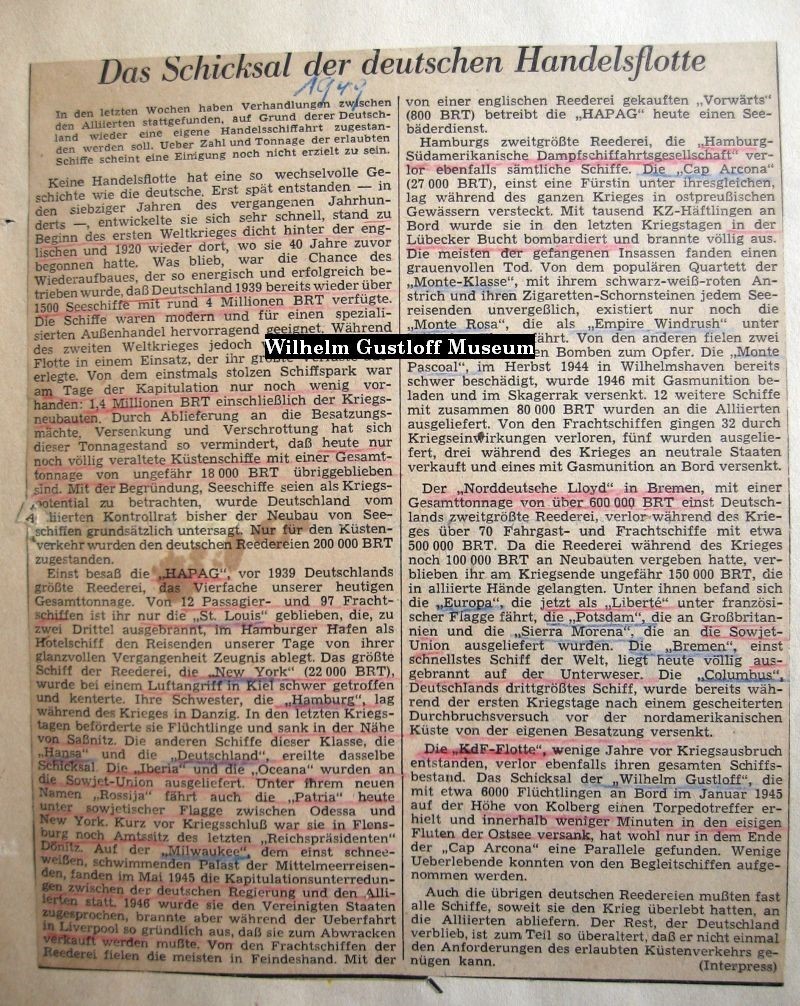
The Shuffle of the German Merchant Fleet - Unknown Newspaper, dated 1949.
In the last few weeks, negotiations between the Allies have been underway, on the basis of which Germany will once again be giving its own merchant ships. There is no agreement yet to be reached on the number of ships and their ships.
No commercial fleet has such a changing history as the German one. It was not until late - in the 1870s - that it developed very quickly. It was close to the English at the beginning of the First World War, and again in 1920, where it was an opportunity for reconstruction, which was so energetic and successful. Already it had more than 1,500 seagoing ships with around 4 million BRTs. The ships were modern and well suited for a specialized foreign trade. During the Second World War, however, the fleet consumed itself in an operation that imposed its greatest losses. From the once proud naval base on the day of the capitulation, there was little left: 1.4 million GRT, including the new war buildings. By delivery to the occupying powers, sinking, and scrapping, this tonnage has diminished so much that only now completely obsolete coastal vessels with a total tonnage of about 18,000 GRT remain. On the grounds that seagoing ships were to be regarded as a war potential, the Allied Control Council had so far forbidden German construction of new ships. Only for coastal transport the German shipping companies received 200,000 GRT.
In the last few weeks, negotiations between the Allies have been underway, on the basis of which Germany will once again be giving its own merchant ships. There is no agreement yet to be reached on the number of ships and their ships.
No commercial fleet has such a changing history as the German one. It was not until late - in the 1870s - that it developed very quickly. It was close to the English at the beginning of the First World War, and again in 1920, where it was an opportunity for reconstruction, which was so energetic and successful. Already it had more than 1,500 seagoing ships with around 4 million BRTs. The ships were modern and well suited for a specialized foreign trade. During the Second World War, however, the fleet consumed itself in an operation that imposed its greatest losses. From the once proud naval base on the day of the capitulation, there was little left: 1.4 million GRT, including the new war buildings. By delivery to the occupying powers, sinking, and scrapping, this tonnage has diminished so much that only now completely obsolete coastal vessels with a total tonnage of about 18,000 GRT remain. On the grounds that seagoing ships were to be regarded as a war potential, the Allied Control Council had so far forbidden German construction of new ships. Only for coastal transport the German shipping companies received 200,000 GRT.
Once HAPAG, before 1939 Germany's largest shipowner, had four times our present total tonnage. Of her 12 passenger and 97 freight ships, she remained only the "St. Louis", which, burned to two-thirds, in the port of Hamburg as a hotel ship testifies to the travelers of our days of their glorious past. The largest ship of the shipping company, the "New York" (22,000 BRT), was heavily hit and capsized in an air strike in Kiel. Her sister, the "Hamburg", was in Gdansk during the war. In the last days of war, she promoted refugees and sank near Saßnitz. The other ships of this class, the "Hansa" and the "Der Deutsche", had the same fate. The "Iberia" and the "Oceana" were handed over to the Soviet Union. Under its new name "Rossija", the "Patria" now also flies under the Soviet flag between Odessa and New York. Shortly before the
1950s
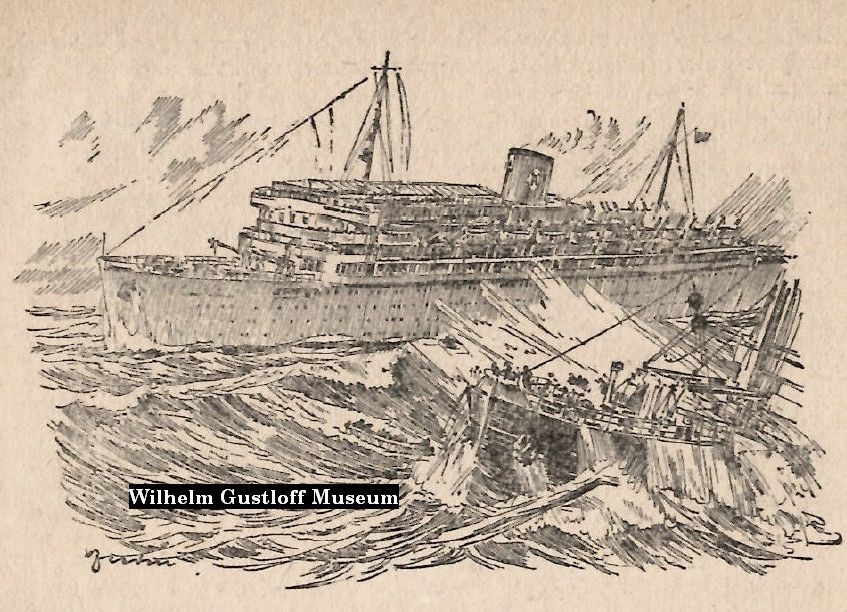

Ten Years Ago: The Sinking of the Wilhelm Gustloff.
Unknown Newspaper Clipping - 1955.
Comes with a blue, handwritten note at the top.
Thanks to Ulli Restemeyer for translating it!
Lieber Gerhard.
Ich will Dir damit eine Freude machen. Du hast ja diese Katastrophe mit erlebt und kannst feststellen ob es auf Wahrheit basiert. Schreib mir bitte mal darüber. Es würde mich sehr interessieren.
Viele Grüsse Deine Lore
Unknown Newspaper Clipping - 1955.
Comes with a blue, handwritten note at the top.
Thanks to Ulli Restemeyer for translating it!
Lieber Gerhard.
Ich will Dir damit eine Freude machen. Du hast ja diese Katastrophe mit erlebt und kannst feststellen ob es auf Wahrheit basiert. Schreib mir bitte mal darüber. Es würde mich sehr interessieren.
Viele Grüsse Deine Lore
Dear Gerhard.
I want to make you happy with it. You've experienced this disaster and can determine if it's based on truth. Please write me about it. I'd be very interested.
Many Greetings, Your Lore
Right: Movie poster for Nacht fiel uber Gotenhafen. Probably released in late 1959 for the early 1960 release.
I want to make you happy with it. You've experienced this disaster and can determine if it's based on truth. Please write me about it. I'd be very interested.
Many Greetings, Your Lore
Right: Movie poster for Nacht fiel uber Gotenhafen. Probably released in late 1959 for the early 1960 release.
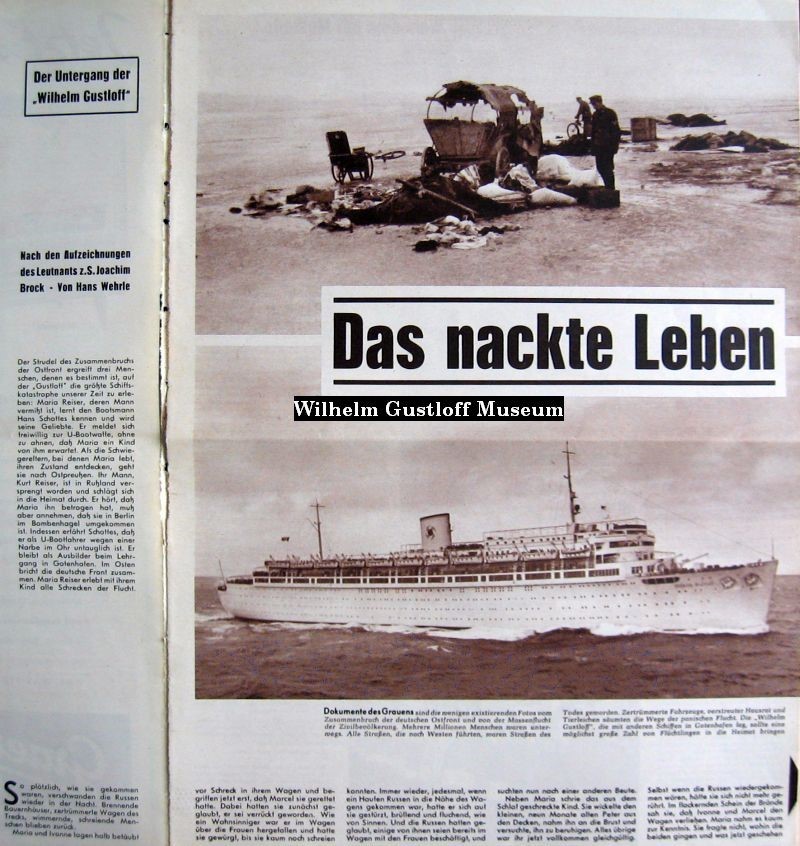
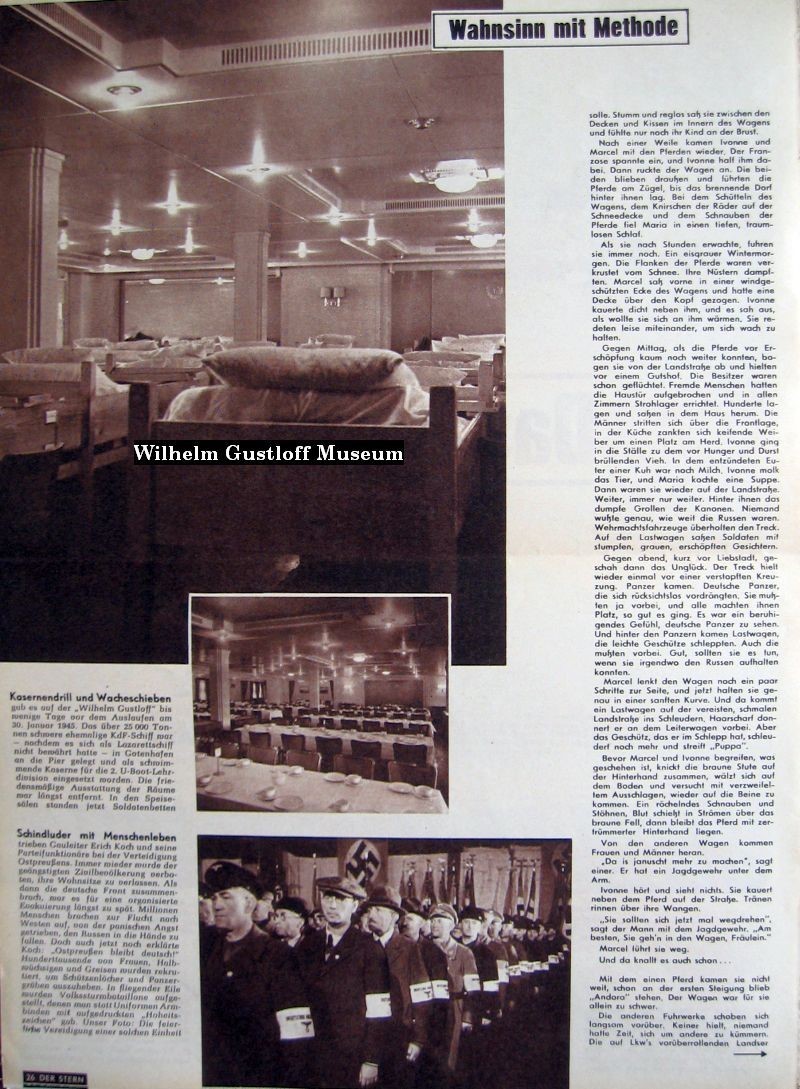
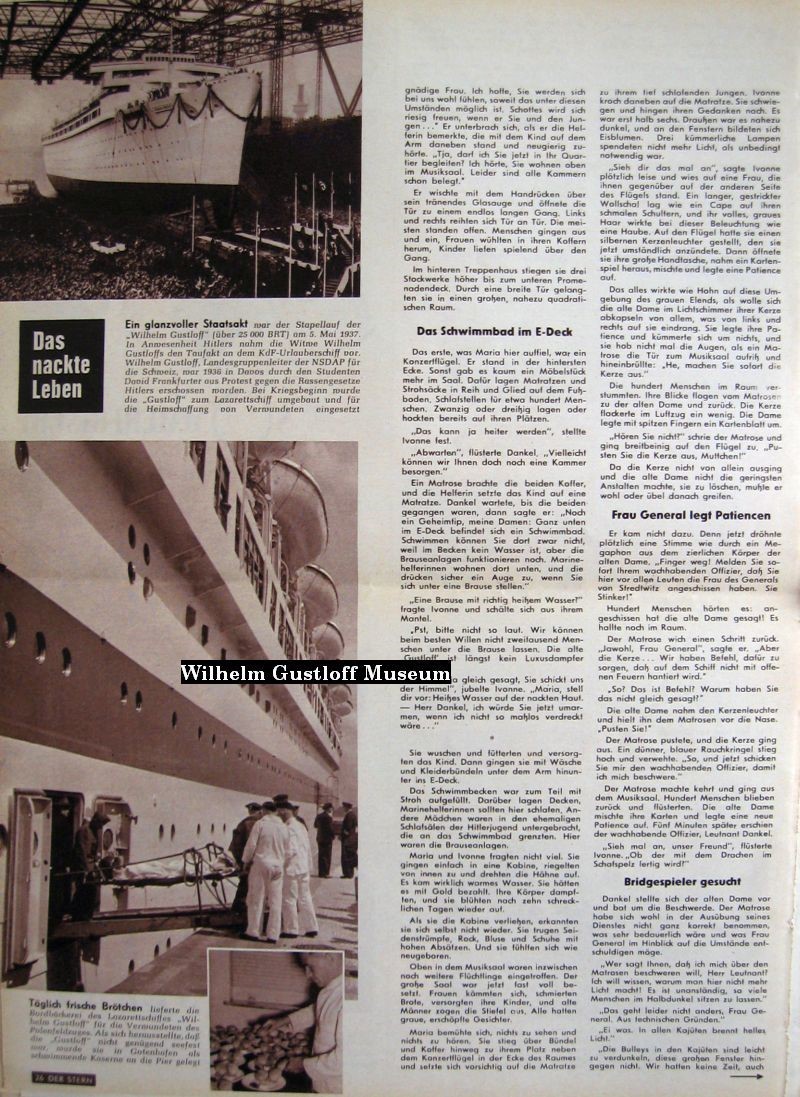
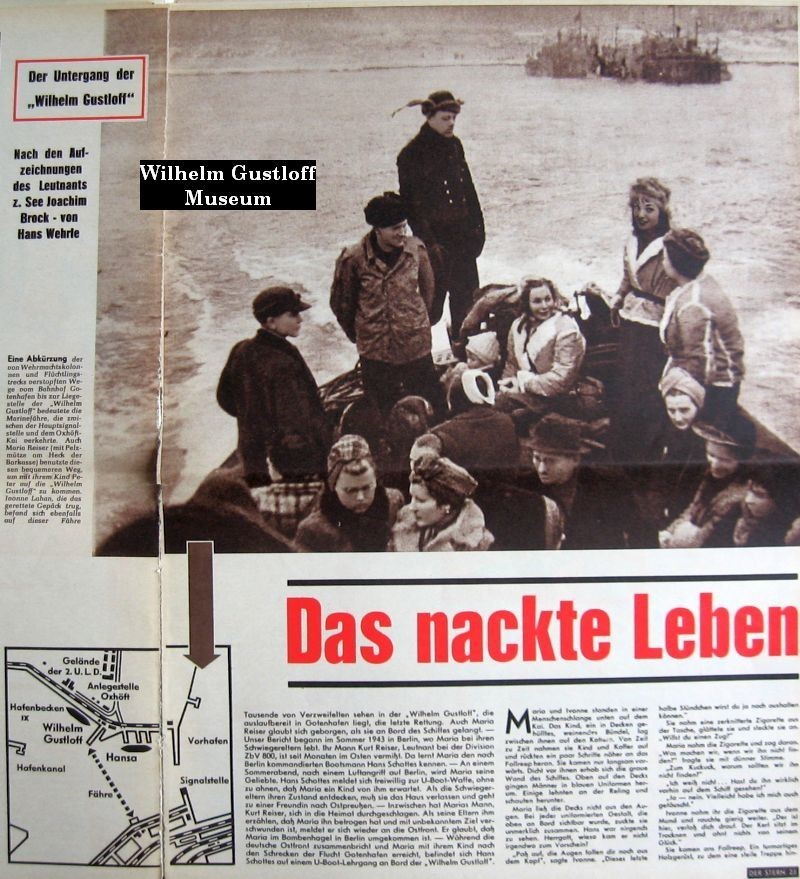
1960s
Untergang der Wilhelm Gustloff Heinz Schön
1960
1960
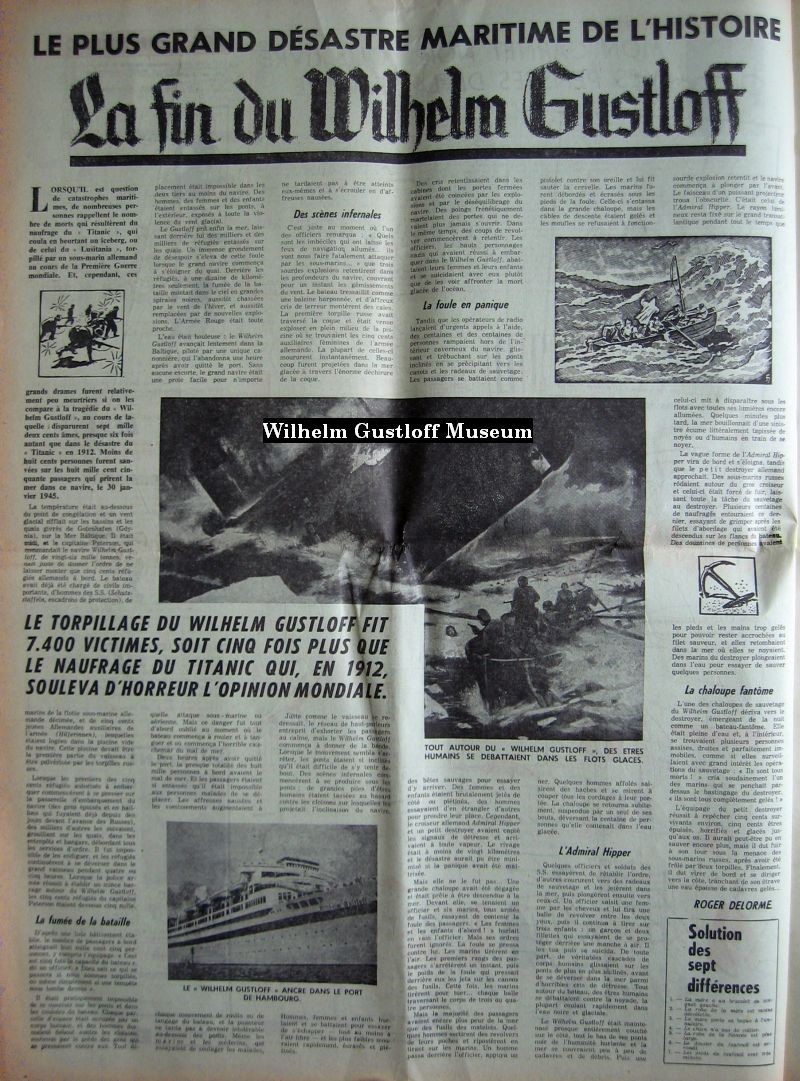
200 Millionen Schatz in dem Schiffswrack
Polen wollen yur "Wilhelm Gustloff" tauchen
200 Million in Treasure in the Shipwreck
Poland wants to dive the Wilhelm Gustloff.
August 10th, 1969 - Unknown Newspaper
Highlighted in red:
"On board were thousands of refugees from West Prussia and from the interior of East Prussia.
Torpedoes from the tubes of a Russian submarine were fired at the steamer. After a short time, the ship catastrophes.
Based on the red markings, hole punches, and the fact that there is only a photocopy in the archive rather than the original, it is believed that these are pieces from the GKP Rekin collection.
This is a collection of photographs and newspaper clippings from when the dive club went to the Gustloff and recovered several artifacts from the wreck around 1973.
Click HERE to view the full archive on PICSSR.
Polen wollen yur "Wilhelm Gustloff" tauchen
200 Million in Treasure in the Shipwreck
Poland wants to dive the Wilhelm Gustloff.
August 10th, 1969 - Unknown Newspaper
Highlighted in red:
"On board were thousands of refugees from West Prussia and from the interior of East Prussia.
Torpedoes from the tubes of a Russian submarine were fired at the steamer. After a short time, the ship catastrophes.
Based on the red markings, hole punches, and the fact that there is only a photocopy in the archive rather than the original, it is believed that these are pieces from the GKP Rekin collection.
This is a collection of photographs and newspaper clippings from when the dive club went to the Gustloff and recovered several artifacts from the wreck around 1973.
Click HERE to view the full archive on PICSSR.

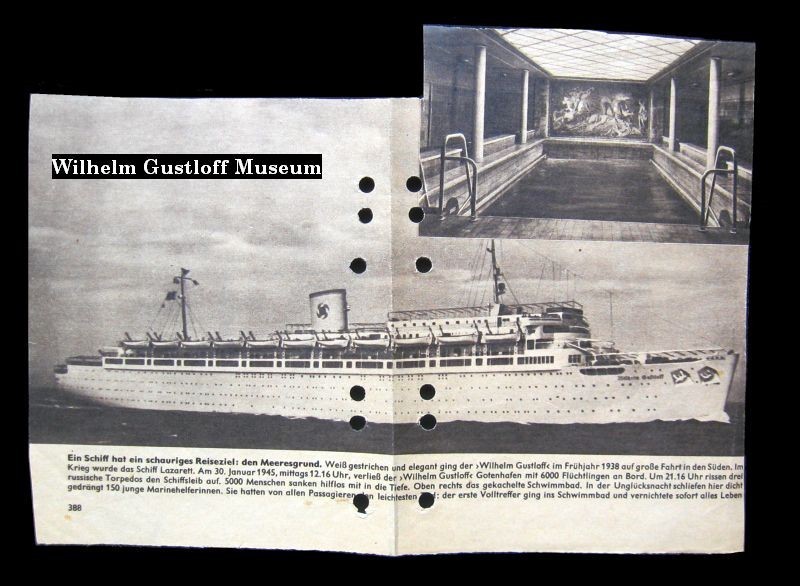
1970s
1980s
1990s
2000s
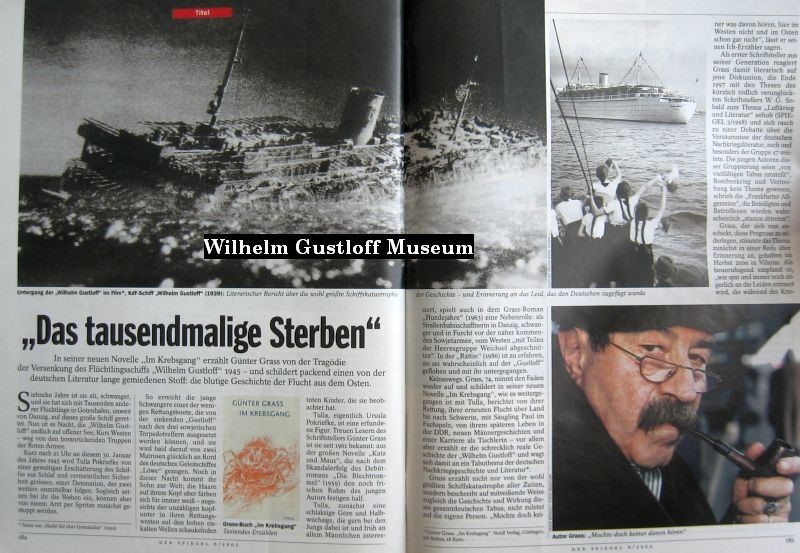
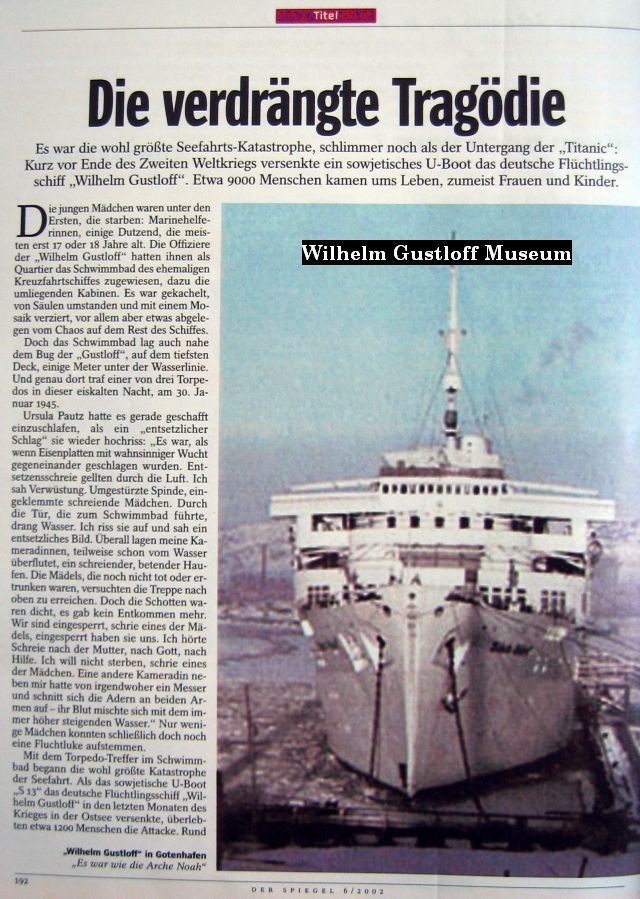


Two books by Heinz Schön:
Left: SOS Wilhelm Gustloff - 1998
Right: Die Gustloff Katastrophe - 1999
Left: SOS Wilhelm Gustloff - 1998
Right: Die Gustloff Katastrophe - 1999
Publications which feature the Wilhelm Gustloff Museum are listed under the Curator's Notes & Links Page.
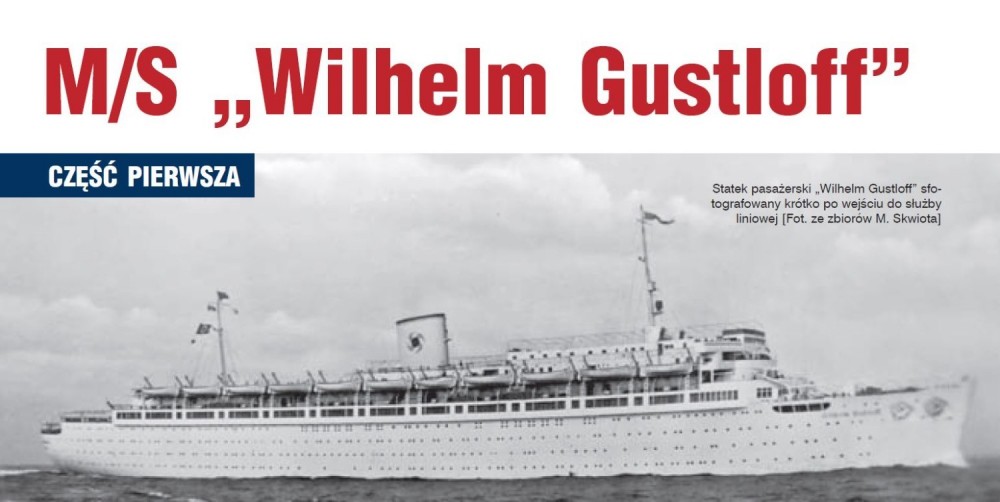
M/S Wilhelm Gustloff articles in Polish
Written by Mirosław Skwiot of GKP "Neptun" Gdańsk. These focus on the dives and artifact recovery on the Wilhelm Gustloff.
ARTICLE #1
ARTICLE #2
Written by Mirosław Skwiot of GKP "Neptun" Gdańsk. These focus on the dives and artifact recovery on the Wilhelm Gustloff.
ARTICLE #1
ARTICLE #2
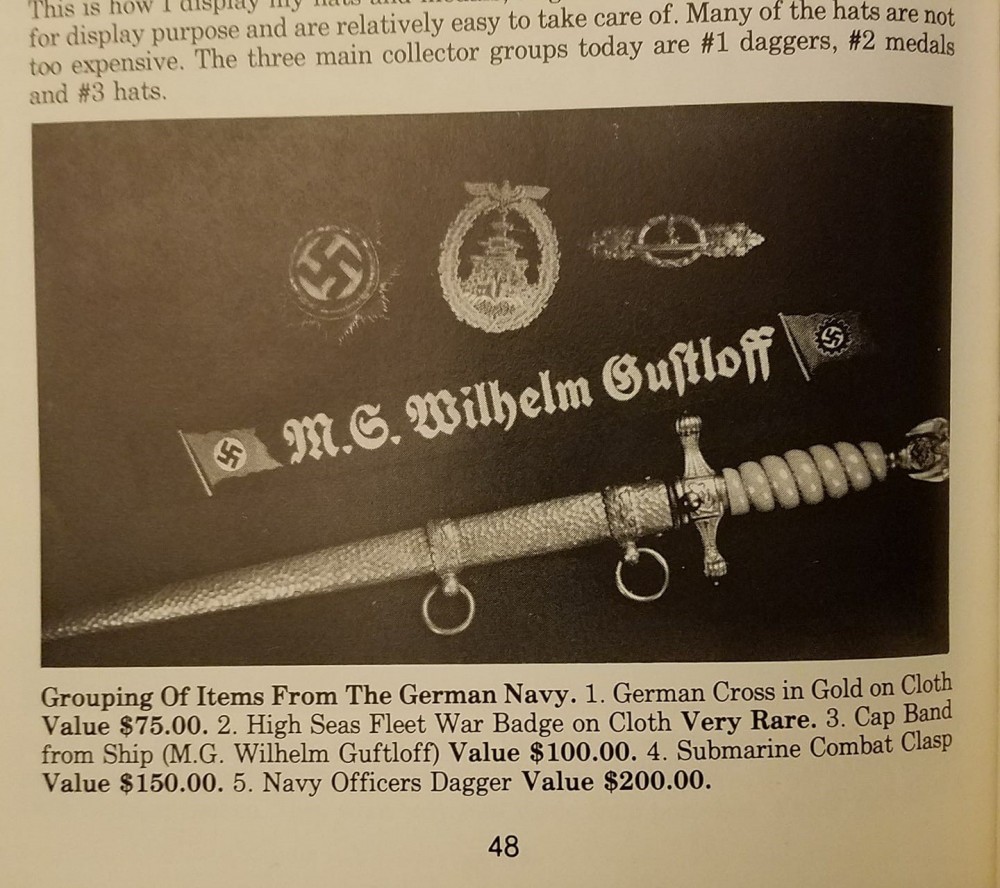
German Military Collectibles - Pricing Guide
Printed in 1980
I came across this tattered book for $1.25 on the shelf of a second hand book store one day. In its pages is a photograph of a Wilhelm Gustloff cap tally valued at $100.00 at that time.
What I found interesting is that the author mis-identified the ship's name, making not one - but two spelling errors: M.G. for M.S. and Guftloff for Gustloff.
Printed in 1980
I came across this tattered book for $1.25 on the shelf of a second hand book store one day. In its pages is a photograph of a Wilhelm Gustloff cap tally valued at $100.00 at that time.
What I found interesting is that the author mis-identified the ship's name, making not one - but two spelling errors: M.G. for M.S. and Guftloff for Gustloff.

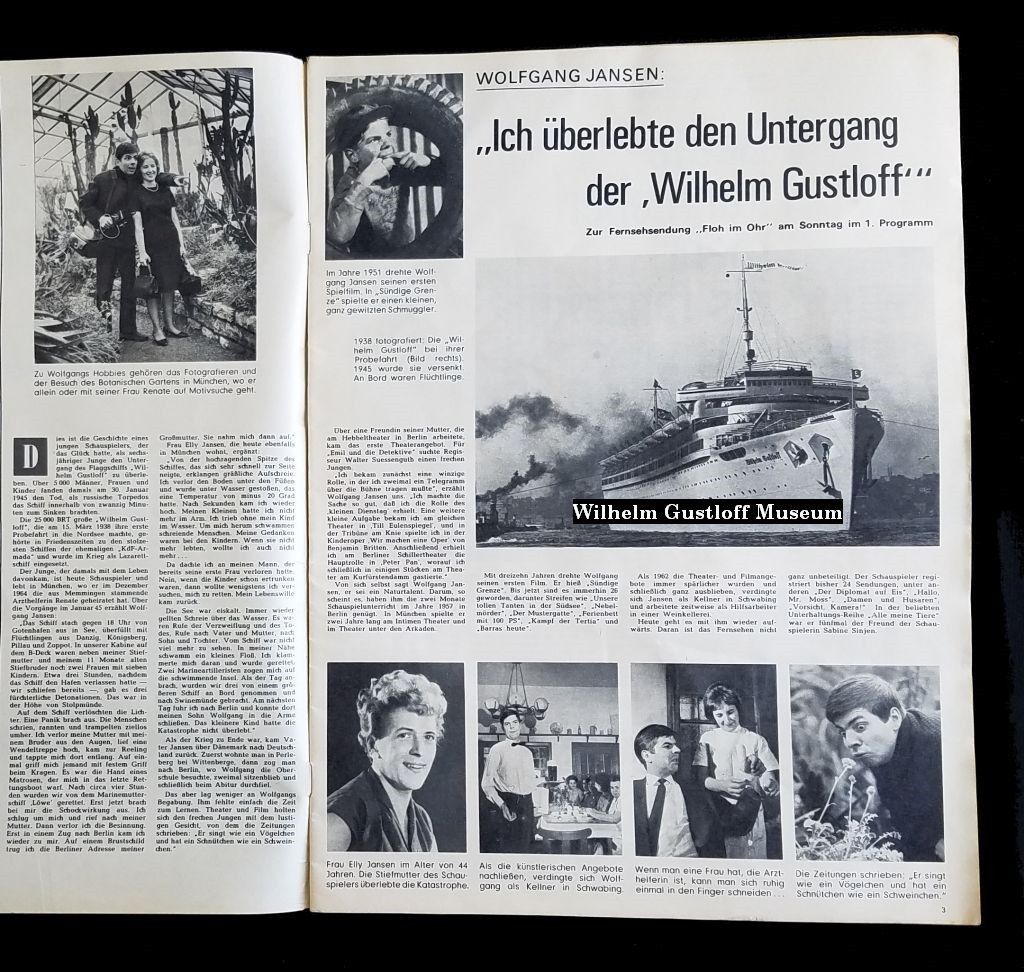
Funk Uhr - June 19th-25th, 1966
"I survived the sinking of the Wilhelm Gustloff."
"I survived the sinking of the Wilhelm Gustloff."
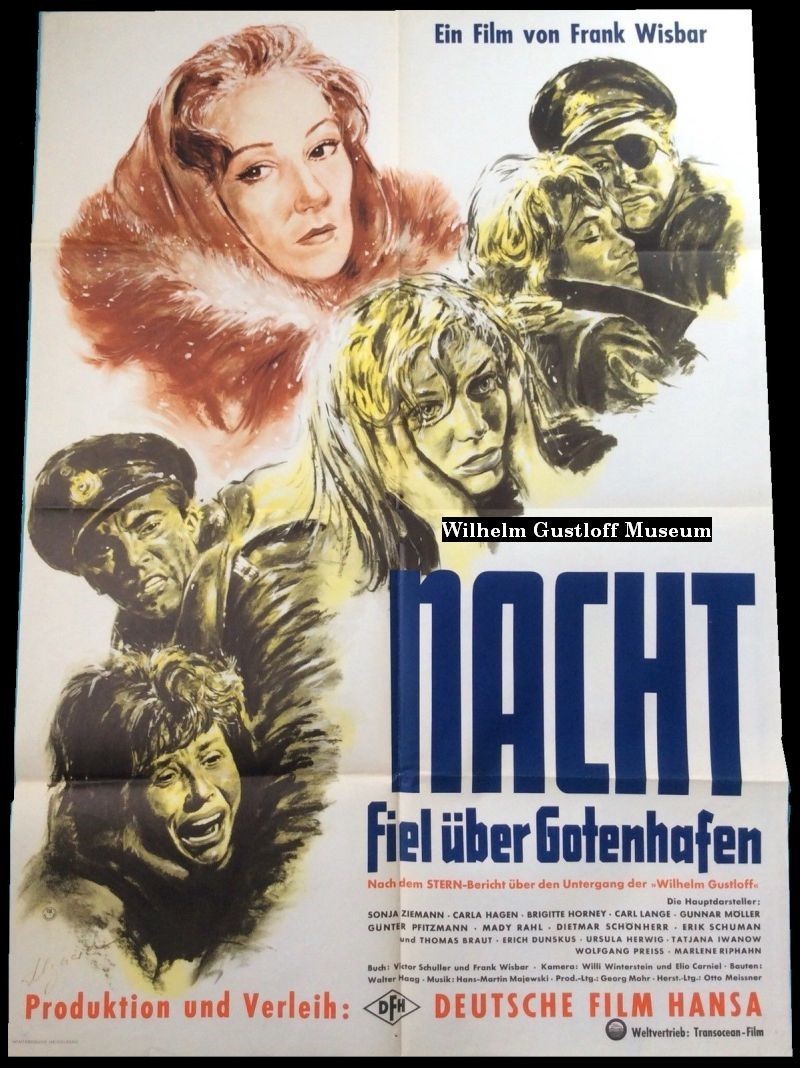
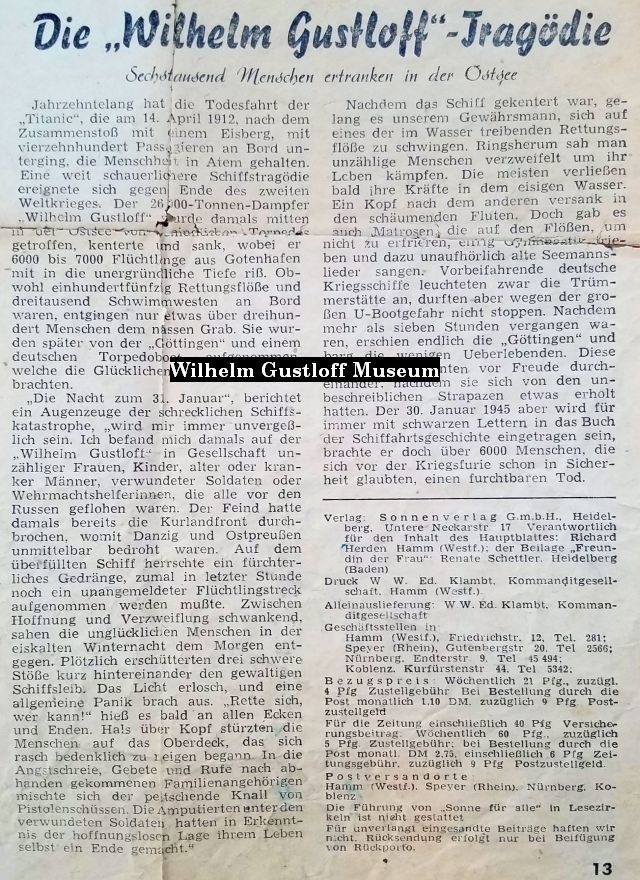
The "Wilhelm Gustloff" Tragedy
Six thousand people drowned in the Baltic Sea
Spring 1951 - Artist rendering of the Wilhelm Gustloff sinking.
For decades, the Titanic's death voyage, which sank on April 14, 1912, after colliding with an iceberg carrying fourteen hundred passengers, kept mankind in suspense. A far more gruesome ship tragedy occurred towards the end of the Second World War. The 26,000-ton steamer Wilhelm Gustloff was then hit in the middle of the Baltic Sea by massive torpedoes, capsized and sank, taking 6,000 to 7,000 refugees from Gotenhafen into the unfathomable depths. Although one hundred and fifty life rafts and three thousand life-jackets were on board, just over three hundred people escaped the wet grave. They were later taken by the Göttingen and a German torpedo boat, which brought the lucky ones to Świnoujście. "The night of January 31," reports an eyewitness to the terrible shipwreck, "will always be unforgettable." At that time I was on Wilhelm Gustloff in the company of innumerable women, children, old or sick men, wounded soldiers or Wehrmacht assistants. The enemy had already broken through the Kurland front, threatening Gdansk and East Prussia directly, and there was a terrible crowd on the overcrowded ship, especially as an unannounced refugee trek had to be taken in the last hour, vacillating between hope and despair, the unfortunate people saw the morning in the freezing cold winter night. Suddenly, three heavy bumps shook the massive ship's body in quick succession. The light went out, and a general panic broke out. "Save yourself, who can!! It's going to be heated all over the place soon. Head over heels, people were leaning on the upper deck, which began to tilt alarmingly. In the screams of fear, prayers and calls for lost family members mingled the whipping bang of pistol shots. The amputees among the wounded soldiers, having realized the hopeless situation, had put an end to their own lives." After the ship capsized, our informant managed to swing on one of the floating rafts in the water. All around you saw countless men desperately fighting for their lives. Most soon left their strength in the icy water. One head after another sank in the foaming flood. But there were also sailors on the rafts, not to freeze, eagerly practiced gymnastics and sang incessantly old sailor's clothes. Passing German warships lit up the rubble, but were not allowed to stop because of the great danger of submarine damage. After more than seven hours had passed, the Göttingen finally appeared and hid the few survivors. They laughed and cried for joy after having recovered from the indescribable hardships. However, January 30, 1945, will be forever entered in the book of shipping history with black letters, since it brought about 6,000 people, who already believed themselves safe from the war fury, a terrible death.
Six thousand people drowned in the Baltic Sea
Spring 1951 - Artist rendering of the Wilhelm Gustloff sinking.
For decades, the Titanic's death voyage, which sank on April 14, 1912, after colliding with an iceberg carrying fourteen hundred passengers, kept mankind in suspense. A far more gruesome ship tragedy occurred towards the end of the Second World War. The 26,000-ton steamer Wilhelm Gustloff was then hit in the middle of the Baltic Sea by massive torpedoes, capsized and sank, taking 6,000 to 7,000 refugees from Gotenhafen into the unfathomable depths. Although one hundred and fifty life rafts and three thousand life-jackets were on board, just over three hundred people escaped the wet grave. They were later taken by the Göttingen and a German torpedo boat, which brought the lucky ones to Świnoujście. "The night of January 31," reports an eyewitness to the terrible shipwreck, "will always be unforgettable." At that time I was on Wilhelm Gustloff in the company of innumerable women, children, old or sick men, wounded soldiers or Wehrmacht assistants. The enemy had already broken through the Kurland front, threatening Gdansk and East Prussia directly, and there was a terrible crowd on the overcrowded ship, especially as an unannounced refugee trek had to be taken in the last hour, vacillating between hope and despair, the unfortunate people saw the morning in the freezing cold winter night. Suddenly, three heavy bumps shook the massive ship's body in quick succession. The light went out, and a general panic broke out. "Save yourself, who can!! It's going to be heated all over the place soon. Head over heels, people were leaning on the upper deck, which began to tilt alarmingly. In the screams of fear, prayers and calls for lost family members mingled the whipping bang of pistol shots. The amputees among the wounded soldiers, having realized the hopeless situation, had put an end to their own lives." After the ship capsized, our informant managed to swing on one of the floating rafts in the water. All around you saw countless men desperately fighting for their lives. Most soon left their strength in the icy water. One head after another sank in the foaming flood. But there were also sailors on the rafts, not to freeze, eagerly practiced gymnastics and sang incessantly old sailor's clothes. Passing German warships lit up the rubble, but were not allowed to stop because of the great danger of submarine damage. After more than seven hours had passed, the Göttingen finally appeared and hid the few survivors. They laughed and cried for joy after having recovered from the indescribable hardships. However, January 30, 1945, will be forever entered in the book of shipping history with black letters, since it brought about 6,000 people, who already believed themselves safe from the war fury, a terrible death.
Newspaper article c1950s of the sinking of the Wilhelm Gustloff.
Untranslated as of now.
Also features an artist rendering of the sinking.
This article and the one above came from the Georgi document collection.
Untranslated as of now.
Also features an artist rendering of the sinking.
This article and the one above came from the Georgi document collection.
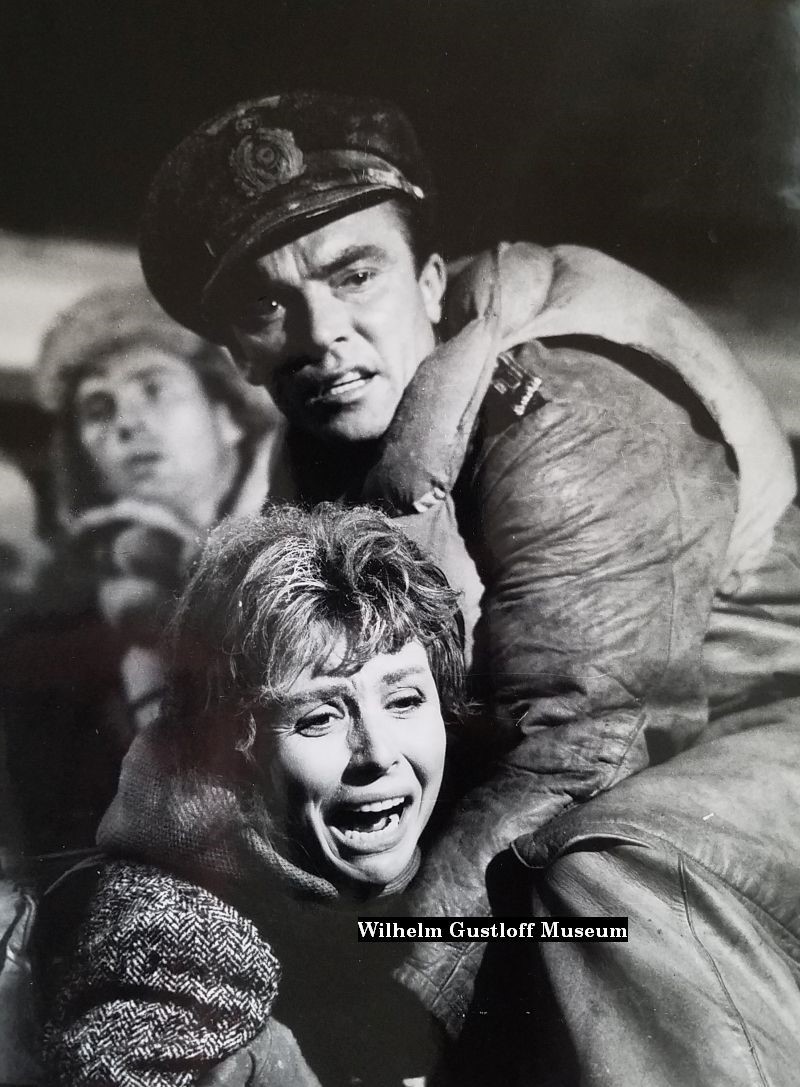
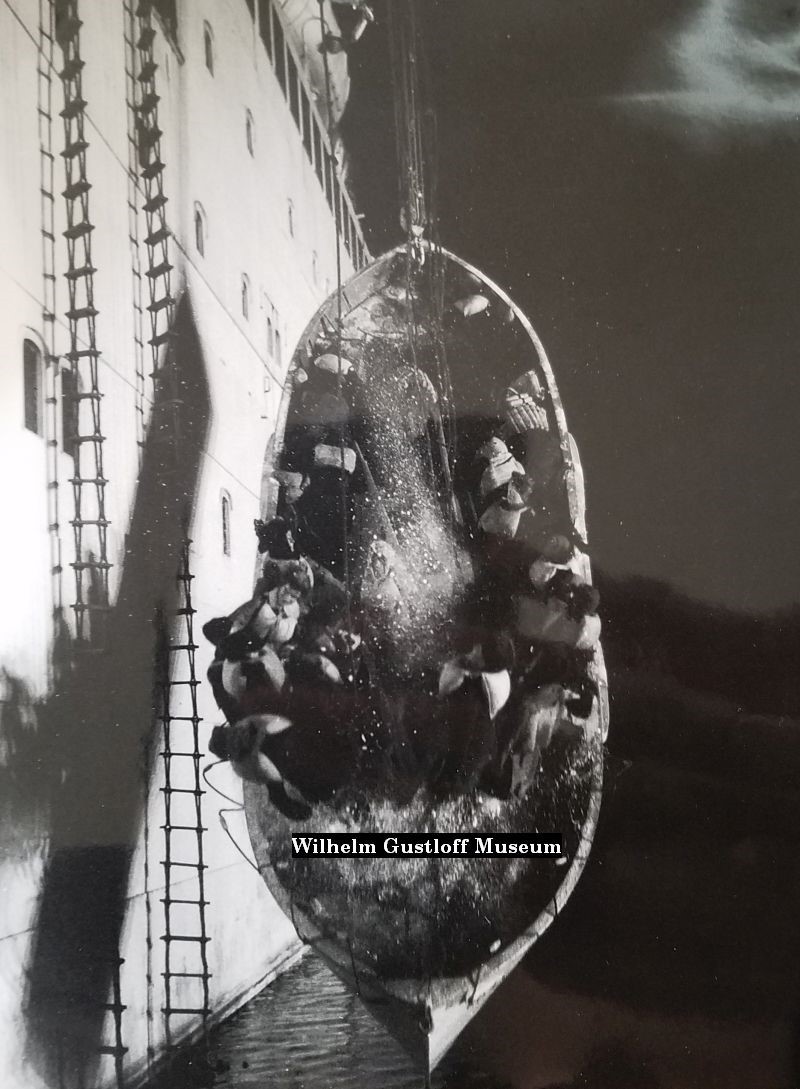
A little known book by Rainer Daehnhardt and Heinz Schön entitled "From Heaven to Hell." Published in English on one side and Portuguese (Do Ceu ao Inferno) on the other out of Lisbon in 2000.
I managed to find a copy from Germany for $40.00 - though I do not know how many they produced. Rainer has insights into the ship's early days for the first half. It is the only known book where the entire latter half is by Heinz Schön and in English. Great read and highly recommended if you can find a copy!
I managed to find a copy from Germany for $40.00 - though I do not know how many they produced. Rainer has insights into the ship's early days for the first half. It is the only known book where the entire latter half is by Heinz Schön and in English. Great read and highly recommended if you can find a copy!

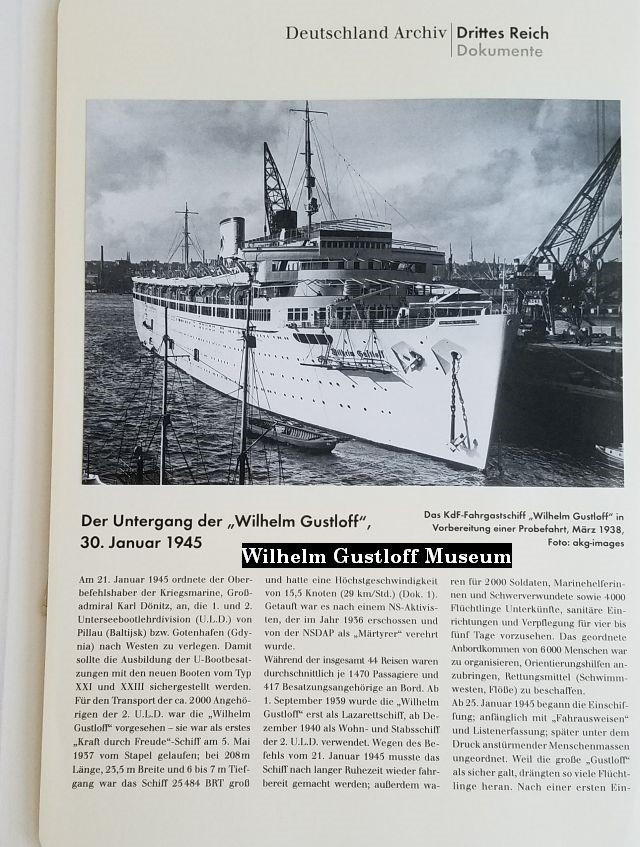
Deutschland Archiv - Drittes Reich Dokumente
Sinking of the Wilhelm Gustloff Set
Date Unknown - c2000s
Featuring a movie poster for Night Fell Over Gotenhafen, images of her interiors, a News for the Troops headline from February 1945, and a reproduction set of deck plans with cabin numbers included.
Sinking of the Wilhelm Gustloff Set
Date Unknown - c2000s
Featuring a movie poster for Night Fell Over Gotenhafen, images of her interiors, a News for the Troops headline from February 1945, and a reproduction set of deck plans with cabin numbers included.